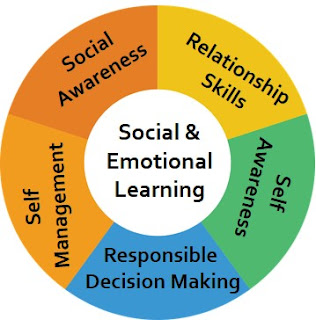Strategies To Embed Social Emotional Learning in Schools
This article was
written originally for MultiBriefs Education.
Brotto goes on to note that the report also noted that the development of SEL skills as early as kindergarten “can have long-term academic benefits on students’ reading and vocabulary, including in high poverty schools, suggesting that SEL may assist in closing achievement gaps.” The report later suggests, “researchers at Columbia University concluded that for every dollar a school spends on social-emotional learning programs, it sees an eleven dollar return on its investment,” indicating the investment in SEL is worthwhile. He concluded by noting the benefits of SEL include better academic performance, improved attitudes, behaviors and relationships with peers, and a deeper connection to school, combined with a reduction in instances of depression, anxiety, stress and social withdrawal.
Student affect and social emotional learning (SEL) are important skills and dispositions that schools must find consistent, deliberate ways to assess. As schools think about college and career readiness, they must know that the critical competencies for success are evolving. Employers are looking for different skills than they did even ten years ago. This Forbes article references a survey by NACE (National Association of Colleges and Employers) which outlines the top four skills employers are looking for in an employee.
● Ability to work in a team
● Ability to make decisions and solve problems
● Ability to plan, organize and prioritize work
● Ability to communicate verbally with people inside and outside an organization
This information creates a certain sense of urgency in schools that have not yet found an effective way to assess these kinds of skills and dispositions. Teachers need to mindfully integrate these skills and dispositions into their curriculum, instruction, and assessment. But the process is one of trial and error. The teacher role really becomes about recognizing opportunities to integrate the learning of skills and dispositions, and very importantly, pointing out times within the day to ask students questions about how they are metacognitively processing information or what is either inhibiting them from being successful within a disposition for allowing them to be successful.
There are multiple factors that need to be considered when developing a rubric for skills and dispositions such as social and emotional learning. They should be assessed using a body of evidence. This is important, because the grade should be based upon multiple points of evidence, rather than just a point in time (end of a quarter or trimester, for example). Rubrics should be developed and then included within assessments. A rubric that is developed for skills and dispositions should focus on ways to identify indicators, based on the targets suggested in each descriptor above, in a developmentally appropriate way.
Students must be held accountable for both academic skill learning outcomes as well as dispositions that have been identified for each grade level and course in the school and/or school system. Both learning outcomes and dispositions should be designed so that demonstration of mastery includes application of skills and knowledge. Assessment of these skills and dispositions should be ongoing, as multiple and varied opportunities exist to each. Expanded learning opportunities should be developed, including those that take place outside of the classroom and school setting, as a way for students to personalize how they will demonstrate mastery of skills and dispositions skills, such as social emotional learning, based on their needs and life experiences in order to help them be college and career ready.




Comments
Post a Comment